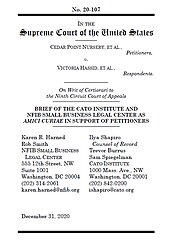Learn more about Cato’s Amicus Briefs Program.
California labor law forces agricultural businesses to allow union organizers onto their property three times a day for 120 days of the year. Cedar Point Nursery operates a strawberry farm in northern California. One morning in the heart of harvest season, union organizers entered the property with bullhorns. As the workers were preparing strawberry plants for shipment, the organizers enjoined the workers to unionize.
Cedar Point filed suit in federal court, arguing that the California law allows for the uncompensated taking of their property in violation of the Fifth Amendment’s Takings Clause. While that might seem like a strange argument because state did not physically commandeer Cedar Point’s property, imagine if your state passed a law allowing people to enter your home on 120 days of the year. A taking can arise from regulations that seriously interfere with ownership, not just the physical occupation or commandeering of property.
The Takings Clause is clear: “nor shall private property be taken for public use, without just compensation.” When the government doesn’t take property outright, it can be a little difficult to figure out when a taking has occurred. Many laws affect and restrict land use, after all. In 1922, in Pennsylvania Coal v. Mahon, Justice Oliver Wendell Holmes wrote that if a regulation “goes too far,” it is akin to a “classic” confiscation. In the 70s, in Penn Central v. New York City, the Supreme Court ruled that measuring whether a regulation “goes too far” means engaging in “essentially ad hoc, factual inquiries” that differ in each case. But in more recent cases called Loretto and Lucas, the Court clarified that physical invasions, however minor, are “per se takings” not subject to Penn Central’s balancing test.
California argues that its law is not a per se taking because it is not “permanent and continuous.” Using Penn Central’s highly deferential test, the Ninth Circuit was more than happy to oblige the Golden State. But the court missed an opportunity to follow what the longstanding Anglo‐American common law makes clear: The “right to exclude” and other fundamental attributes of ownership—the sticks in the bundle of property rights—deserve Loretto’s and Lucas’s categorical protection.
It’s been a long trip for Cedar Point. Cato first filed a brief in the case in the Ninth Circuit in 2016. Now, however, the Supreme Court has agreed to hear the case and Cato, joined by the National Federation of Independent Business Legal Center, has filed an amicus brief urging the Court to overrule the Ninth Circuit. We ask the Court to accord the right to exclude the same constitutional defense as in Loretto and Lucas. The only difference from Loretto is the duration of the taking. But the right to exclude is all or nothing. Sometimes, the right to exclude can be overridden to accommodate serious public needs, but those are rare occasions. As the Court in Lechmere v. NLRB observed, even if unionizing workers is a serious public need, unions have myriad ways to try to organize workers other than invading private property.
A regulation that disrupts an owner’s right to exclude others from their property, however slight, effects a total interference with that right. When it comes to the right to exclude, there is no practical difference between classic and regulatory takings. Whatever label a court applies, the result is the same: The owner cannot at all times choose who enters their property. The Court should overrule the Ninth Circuit, clarifying that the Takings Clause protects private property by preserving the fundamental elements of ownership.

This work is licensed under a Creative Commons Attribution-NonCommercial-ShareAlike 4.0 International License.


